“It is not very often that I would travel for the sake of watching and enjoying the companionship of wild birds but on December 2009 I made my first solo bird photography trip to HongKong. I was well received by my host Mr KK Hui, a retired chartered engineer turned accredited Fellow of The Royal Photographic Society (FRPS). As with those countless encounter out field when strangers just become friends linked by our common interests in birds, I got to know KK via another birding mate. While we have never met in person, that did not pose as a barrier to our communication.
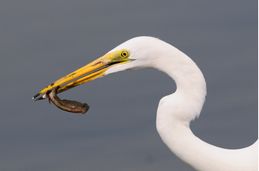
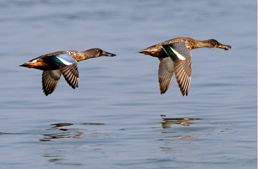
[L: Greater Egret taking a mudskipper. R: Chasing Northern Shoveler with shellfish in beak]
“The place on our agenda was known as Nam Sang Wai (NSW), a stretch of river where hundreds of winter visitors feed yearly. According to KK, one can expect to observe a different species landing with each passing week towards late spring at close proximity (within meters), distances that are impossible to achieve locally without first flushing the avians. One possible explanation for their high tolerance of human presence could be attributed to the geographic location of the river bank and the river itself: the river bank is on higher ground at a meter about the river level, thereby creating an impression of alienation to the feeding birds in the river at low tide. Guided by a good tutor and an adolescent heart, we took a 45mins drive along the country side from the buzzing city centre the next morning after I landed.
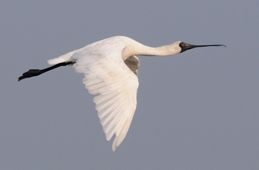
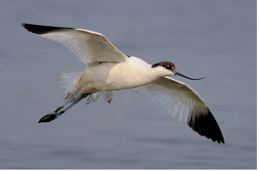
[L: Endangered Black-faced Spoonbill. R: Pied Avocet pre-landing gears down]
“My senses were first assailed when we were greeted by a flock of great cormorants against the brightening morning sky by the left filter from the highway driving into NSW. They appeared as black triangles aligned in the typical arrow-head formation in flight overhead. To our left are some abandoned prawn rearing farms or otherwise known as ke wai, with the fertile river to our right. It took another 5mins drive-in before we arrived at the intersection of Shan Pui River and Kam Tin River, where we parked and unpacked for some nice bird-in-flight (BIF) images.
The feeling of watching hundreds of shore birds feasting on the river bed at close proximity under gusting chilling wind conditions is nothing short of amazing. A quick check on my guidebook revealed the following: 1. Northern Shoveler; 2. Common Pintail; 3. Crested Grebe; 4. Gull; 5. Great Egret; 6. White-napped Raven; 7. Osprey; 8. Peregrine Falcon; 9. White-bellied Sea Eagle; 10. Common Teal; 11. White Wagtail; 12. Common Sandpiper; 13. Great Cormorant; 14. Pied Avocet; 15. Black-wingged Stilts; 16. Black-faced Spoonbill; 17. Little Egret; 18. Grey Heron; 19. Javan Pond Heron; 20. Common Pochard; 21. Tufted Duck; 22. White-throated Kingfisher; 23. Starlings and 24. Black-headed Gull.
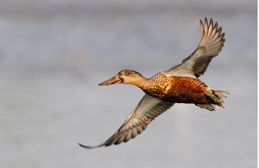
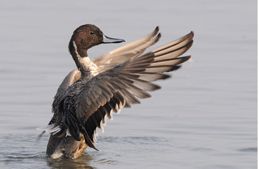
[L: Northern Shoveler performing a fly-pass with full wing-spread. R: Common Pintail stretching its wings early morning]
“Based on the photographs taken, it appearred these wintering birds are feeding off the river on shell-fish and mud-skippers among others. Interestingly, the ducks are curious as usual and would attempt to check out the row of photographers lining the shore by swimming within 5 metres proximity. Feeding may also occur at such distance, suggesting comfort behaviour even in the presence of humans. Tolerant as these birds are to humans, some events can easily trigger a mass take-off. They include a motor boat cruising pass and the raving engine of a rubbish truck.
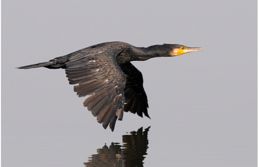

[L: Great Cormorant flying over calm water. R: Starlings taking off in great numbers]
“Territorial dispute over food is rare and few in-between, normally observed to occur between pair of ducks and avocets. In particular, a Pied Avocet demonstrated aggressive behaviour when it consistently chased an incoming Avocet away by trying to pin its opponent down under. Each time, the lesser bird would cower and take flight for the opposite shore, only to return minutes later to try its luck again. This cyclic behaviour offered delightful moments for action shots.


L: Black-wingged Stilt fly-pass. R: Common Teal Landing with a splash]
“While replenishing food supply is a top priority for these wintering birds, sex is also readily observed for some species of ducks. On two separate occasions spread over 2 days, a pair of pintail was observed to demonstrate some frolicking behaviour in the shallow water about 10 meters away, with one bird pinning the other bird under water, leading myself and other observers to conclude these actions to be ‘duck-rape’.
 “On the opposite shore, a White-naped Raven easily double the size of a normal house crow was observed to harass some feeding shorebirds over 3 afternoons. Each time the Raven landed, the surrounding feeding shore birds would take flight, with only the grey herons staying put.
“On the opposite shore, a White-naped Raven easily double the size of a normal house crow was observed to harass some feeding shorebirds over 3 afternoons. Each time the Raven landed, the surrounding feeding shore birds would take flight, with only the grey herons staying put.
“Probably attributed to the winter season, most of the shore birds are in non-breeding plumages. For example, the pintail are lacking the diagnostic pin and gorgeous plumages and some Black-wingged Stilts showed partial black head-dress. Tis perhaps the draw of full breeding plumages that beckons that I shall return once again to this fertile river in Mar 2010. Probably this time round I’d spend more time at the Mai Po nature reserve to bring more interesting content to share.” [L: Black-headed Gull landing for a fish]
Dr Jeff Lim
Singapore
January 2010









3 Responses
Dr. Lim, Great pictures, and account of your trip. Thank you for making the effort to
share …..
This is a refreshing trip report, very unlike the boring lists after lists generated by twitchers. I love the inclusion of various aspects of bird behaviour, making reading a pleasure. Slowly, bird behaviour is apparently gaining popularity among local birdwatchers.
thx. i m interested in species that exhibit consistent/predictable behaviour as much as mammalian behavior enchanted me.